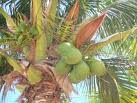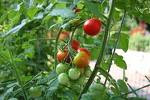WATERMELON, TARBOOZ IN URDU, CITRULLA LANTANA
Watermelons (Tarbooz in Urdu and Adwana in Punjabi) originated in Africa and were discovered growing wild by the famous explorer, Dr Livingstone. They have sustained the Kalahari Bushmen for centuries, supplying them with much needed liquid and nutrition. They are believed to have been cultivated in many different regions in antiquity, including in the Mediterranean region, North Africa and Sardinia as well as the Indian subcontinent.
 In the 16th and 17th centuries they were described by European botanists as having yellow, white as well as pink and red flesh. They are members of the Cucurbitaceae family of plants and so are related to pumpkins, gourds such as the ash gourd, (petha), marrow, courgettes and the yellow melon. Today you can buy seedless melons which have been genetically engineered, but in Asia and Greece, watermelon seeds are dried and roasted either with or without salt, as pumpkin seeds are and eaten as snacks. The seeds may be white, green, black, or speckled, and are as varied as the watermelon (actually a vegetable not a fruit) which comes in different shapes (square and heart-shaped for example) and sizes, from small 3 lb watermelons to those weighing a hefty 90 lbs.
In the 16th and 17th centuries they were described by European botanists as having yellow, white as well as pink and red flesh. They are members of the Cucurbitaceae family of plants and so are related to pumpkins, gourds such as the ash gourd, (petha), marrow, courgettes and the yellow melon. Today you can buy seedless melons which have been genetically engineered, but in Asia and Greece, watermelon seeds are dried and roasted either with or without salt, as pumpkin seeds are and eaten as snacks. The seeds may be white, green, black, or speckled, and are as varied as the watermelon (actually a vegetable not a fruit) which comes in different shapes (square and heart-shaped for example) and sizes, from small 3 lb watermelons to those weighing a hefty 90 lbs. The Moors took them to Spain during the 13th century, and they traveled through Europe afterwards. Watermelon seeds were found in the tomb of Tutankhamen and were cultivated in Egypt along the river Nile at least as far back as 2,000 BC.
A tisane made from the cut seeds will purify the system and help to dissolve kidney gravel and stones. You need a tablespoon of powdered or chopped watermelon seeds to a pint of boiling water. Pour the water over the seeds and allow them to steep for 15 minutes. Strain and drink the tisane.
Watermelons are not only delicious but incredibly beneficial to our health. The red fleshed ones contain lycopene which has potent antioxidant activity and which protects against cancers and heart disease. It is generally known to be found in tomatoes and red carrots, and is what makes fruit and vegetables red. Tomatoes need to be cooked to release the full properties of lycopene, but that in watermelons doesn’t need to be released in this way. However it is best to store them at room temperature in order to get the most out of their potential health benefits. Watermelons are rich in vitamin C and the mineral potassium and contain amino acids including citrulline which is especially rich in yellow and orange fleshed varieties and which helps in healing wounds and cell division. A watermelon also contains other vitamins including vitamin A, D, E and K and the B-complex vitamins and is particularly high in B6. As for minerals it apart from potassium it contains calcium, copper, iron, phosphorous, manganese, magnesium, selenium, sodium and zinc.
 |
| Golden Watermelon |
Research has found that men who combine eating watermelon and drinking green tea, or eating pink grapefruit, strawberries, pommelo, tomatoes and other lycopene rich fruits (apricots, papaya, and guava) help reduce the risk of prostate cancer.
 Citrulline is an amino acid which our bodies use to produce another amino acid, arginine which is used by the urea system to remove ammonia from our bodies. This also helps the cells lining our blood vessels to make nitric oxide which relaxes blood vessels and so lowers high blood pressure. Arginine works on the immune system and benefits the heart and circulation. It is a kind of natural Viagra as it relaxes the blood vessels and so helps reduce problems associated wit erectile dysfunction. In other words watermelon is an aphrodisiac for men. The combination of citrulline-arginine may also prove to be helpful to those who are obese and who have Type 2 diabetes. Research is underway to breed a watermelon in which lycopene is more prevalent in the flesh than the rind as is the case in most varieties of watermelon currently. (The rind can be eaten if pickled.) However it is still more concentrated in watermelons than tomatoes.
Citrulline is an amino acid which our bodies use to produce another amino acid, arginine which is used by the urea system to remove ammonia from our bodies. This also helps the cells lining our blood vessels to make nitric oxide which relaxes blood vessels and so lowers high blood pressure. Arginine works on the immune system and benefits the heart and circulation. It is a kind of natural Viagra as it relaxes the blood vessels and so helps reduce problems associated wit erectile dysfunction. In other words watermelon is an aphrodisiac for men. The combination of citrulline-arginine may also prove to be helpful to those who are obese and who have Type 2 diabetes. Research is underway to breed a watermelon in which lycopene is more prevalent in the flesh than the rind as is the case in most varieties of watermelon currently. (The rind can be eaten if pickled.) However it is still more concentrated in watermelons than tomatoes. If you buy a whole watermelon, hit it to see if it is ripe. If it has a hollow sound then it is. You can liquidize watermelons to extract the juice and this is delicious, but my favourite way of eating it is with Feta cheese. This may sound weird, but try the Greek recipe below.
Ingredients
1 watermelon, cut into cubes or scooped out into balls
4 oz Feta cheese, crumbled or sliced
1 cucumber, peeled and sliced (optional)
Simply put the watermelon on a plate and add crumbled or sliced Feta cheese and a cucumber if you want to. You don’t need salt because of the Feta.
This has Taste and is a Treat




































